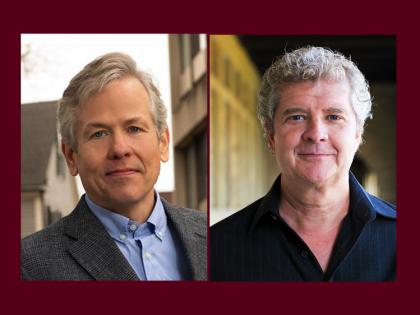Few of us could build a full-size house without a blueprint, yet birds construct elaborate and painstaking homes using only a beak and, perhaps, a foot.
 |
| Above: a drawer of Anna's and Costa's hummingbird (Calypte anna and C. costae) nests collected in the late nineteenth century from California. Below: an osprey (Pandion haliaetus) nest with eggs. |
 Photographs by Jim Harrison |
They aren't taught. "Birds inherit genetic information about building nests," says Museum of Comparative Zoology senior ornithologist Douglas Causey, who presides over a collection of 25,000 nests that shows their astonishing variety across bird species. But even though nest design ranges from minimalist to baroque, miniature to massive, Causey explains, "All individuals of the same species make more or less the same kind of nest."
Hummingbirds, for example, build shelters about two inches in diameter that resemble soft, shallow cups. Every banded wren in Costa Rica seeks out the same material (a silvery lichen akin to Spanish moss) to construct a nest with a roof that provides shelter from rain runoff. More typically, variation within the same species occurs not in design, but in building materials: Causey describes a robin's nest made of discarded telephone wire, and a cliff swallow's mud nest that was rendered permanent when the bird substituted cement. "I've even seen a nest of barbed wire," he says.
Birds can also adapt their nests to suit new environments. Street pigeons, for example, no longer build nests on seaside crags, as their wild ancestors did. Instead, they appropriate window ledges, fire escapes, and rusted nooks beneath bridges.
Regardless of material or design, all nests serve the same purpose: to protect eggs and chicks from predators like snakes and owls. Their constructiona laborious process of gathering twigs, weaving grass, packing mud or, in the case of Canada geese, plucking their own downis part of the mating ritual. Each breeding season, for example, green herons repeat the entire twig-gathering and arranging sequencethe male gathers and the female constructsto add to their existing nest until in time it rises from the marshland's cattails like a brittle, gray crown. In Ohio, after several decades of additions to an eagle aerie, the tree containing it finally collapsed under the two-ton weight. "It is possible that several different eagle pairs made the nest," Causey notes. "Often a nest abandoned for some reason, such as the death of one or both of the parents, is then adopted by new parents."
Today, collecting birds' nests is about as popular as collecting arrowheads, although both were beloved hobbies just 50 years ago when the United States was more rural. "Modern ornithology has moved beyond nests," says Causey, whose primary research involves the evolution and ecology of birds and viruses, such as West Nile and influenza. In fact, most of the Harvard collection's nests and eggs were obtained in the late nineteenth and early twentieth centuries, many by the renowned ornithologist William Brewster, one of the museum's first curators. The century-old specimens, each meticulously labeled by hand according to species, collection date, and locale, and stored in an archival glass box, are tucked away in enormous cabinets. By the 1920s, the vast collection contained specimens of every kind of nest believed to exist in North America. "There was no reason to keep collecting," says Causey. "We had identified all the nests; we'd answered all our questions regarding nests, and we couldn't come up with any more."
 |
Above: Douglas Causey holding an oropendula (Psarocolius spp.) nest. Oropendulas are very large orioles found in Central and South America, and nest in dense colonies. Scores of such nests may hang from the upper branches of a palm tree. Below: nest and eggs of a meadowlark (Sturnella magna) collected by John E. Thayer on June 5, 1911, in Lancaster, Massachusetts.  |
| Photographs by Jim Harrison |
Today's researchers benefit from the collection's pristine origins. Because the nests and eggs predate most environmental pollutants and pesticides, scientists can use the specimens as yardsticks to measure the effect and extent of such contaminants. Rachel Carson's 1962 book Silent Spring, for example, highlighted the insidious damage caused by the insecticide DDT during the 1940s and '50s. By the 1960s, peregrine falcon populations were dwindling and their eggs were regularly breaking during incubation. Scientists wondered if eggshell thickness and durability had changed significantly over the years, and sought century-old eggs for comparison. "Suddenly, the collection became very important for documenting this," says Causey. Sure enough, the old eggshells were stronger and thicker. As Carson had predicted, the falcons' ingestion of DDT had weakened the newer shells.
Botanists, meanwhile, continue to use the museum's collection to study old nest materials in order to ascertain changes in regional flora over time. "You can determine what was around in Texas when this bird's nest existed," Causey explains, holding up a specimen from 1906 and examining its neatly printed label. "It's like a time capsule."
~Catherine Dupree
Douglas Causey e-mail address: dcausey@oeb.harvard.edu







